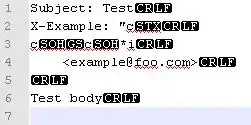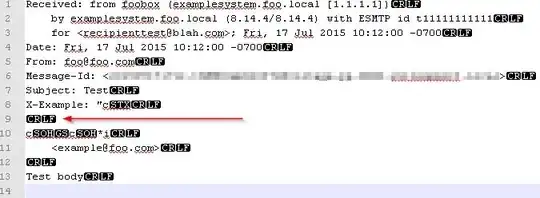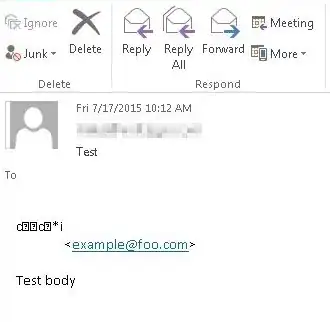That is pretty simple actually: RFC 2822 section 2.2.3 allows for long headers, where a header is a fieldname followed by a : to fold and continue on the next line, as long as (simplified) that next line starts with a space
The general rule is that wherever this standard allows for folding white space (not simply WSP characters), a CRLF may be inserted before any WSP. For example, the header field:
Subject: This is a test
can be represented as:
Subject: This
is a test
Line 3 of the original input starts not with a space, but with the character c and does not contain a colon : which makes it neither the continuation of the previous header nor the next header field (§2.2).
That marks it as the end of the headers...
And the start of the body.
Sendmail "corrects" that malformed message and adds the required blank line between what it perceives as end of the the headers and start of the body.
A simple telnet mail session can reproduce that behaviour:
[user@example ~]$ telnet localhost 25
Trying 127.0.0.1...
Connected to localhost.
Escape character is '^]'.
<<< 220 example.com ESMTP Sendmail 8.14.4/8.14.4; Fri, 17 Jul 2015 20:29:26 +0200
helo localhost
<<< 250 example.com Hello localhost [127.0.0.1], pleased to meet you
mail from:me@localhost
<<< 250 2.1.0 me@localhost... Sender ok
RCPT TO:user@example.com
<<< 250 2.1.5 user@example.com... Recipient ok
data
<<< 354 Enter mail, end with "." on a line by itself
Subject: test
X-header: do not try
this at home
start the body
.
<<< 250 2.0.0 t6HITQXA020072 Message accepted for delivery
quit
Which results in similar message as your example:
[user@example ~/Maildir/new]$ cat 1437157845.20091_2.example.com
Return-Path: <me@example.com>
X-Spam-Checker-Version: SpamAssassin 3.3.1 (2010-03-16) on example.com
X-Spam-Level:
X-Spam-Status: No, score=-1.9 required=5.0 tests=ALL_TRUSTED,BAYES_00,
MISSING_HEADERS autolearn=no version=3.3.1
Received: from localhost (localhost [127.0.0.1])
by example.com (8.14.4/8.14.4) with SMTP id t6HITQXA020072
for herman@example.com; Fri, 17 Jul 2015 20:30:06 +0200
Date: Fri, 17 Jul 2015 20:29:26 +0200
From: me@example.com
Message-Id: <201507171830.t6HITQXA020072@example.com>
Subject: test
X-header: do not try
this at home
start the body
With an additional new line between the original header continuation and the "new" start of the body.

 (ips, Q-ID, and hostname changed to protect the innocent)
(ips, Q-ID, and hostname changed to protect the innocent)